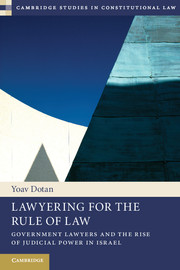Book contents
- Frontmatter
- Dedication
- Contents
- Acknowledgments
- List of figures
- List of tables
- Introduction The government’s lawyer
- 1 The Israeli legal system and the rise of judicial activism in the High Court of Justice
- 2 The High Court of Justice Department (HCJD): overview and history
- 3 Litigating for the government
- 4 The dilemma of serving two masters
- 5 Sorting things out: government lawyers in transformative litigation
- 6 The government lawyer as adjudicator: “pre-petitions” and the HCJD
- Conclusion
- Table of Cases
- Bibliography
- Index
Conclusion
Published online by Cambridge University Press: 05 June 2014
- Frontmatter
- Dedication
- Contents
- Acknowledgments
- List of figures
- List of tables
- Introduction The government’s lawyer
- 1 The Israeli legal system and the rise of judicial activism in the High Court of Justice
- 2 The High Court of Justice Department (HCJD): overview and history
- 3 Litigating for the government
- 4 The dilemma of serving two masters
- 5 Sorting things out: government lawyers in transformative litigation
- 6 The government lawyer as adjudicator: “pre-petitions” and the HCJD
- Conclusion
- Table of Cases
- Bibliography
- Index
Summary
Throughout this book I have described the working practices and functions of lawyers who represent the Israeli government before the Supreme Court. The group I focused on is a relatively small group of elite government lawyers who are certainly distinct in their position and functions from the general population of government lawyers in Israel, let alone from government lawyers at large. Nevertheless, the study of this group of lawyers may contribute to our understanding of the phenomenon of government lawyering, their influence within the governmental bureaucracy, and their relationship with the judiciary.
The evolvement of the “lawyering for the rule of law” model during the 1980s in Israel was closely intertwined with the rise of judicial activism within the High Court of Justice. During this era the court was transformed from a relatively restrained court that viewed its main mission as deciding controversies between individuals and state agencies to a powerful and interventionist institution that views its main role as enforcing the principles of the rule of law over the Israeli executive and political branches. The discussion of the causes of this shift by the court, and the background reasons for the pace and the magnitude of the process, are largely beyond the scope of this book. It is clear, however, that the reforms initiated by the court stirred a process of change within various other institutions (within and without the Israeli bureaucracy). The HCJD was one of the key institutions in this respect.
- Type
- Chapter
- Information
- Lawyering for the Rule of LawGovernment Lawyers and the Rise of Judicial Power in Israel, pp. 188 - 190Publisher: Cambridge University PressPrint publication year: 2013

